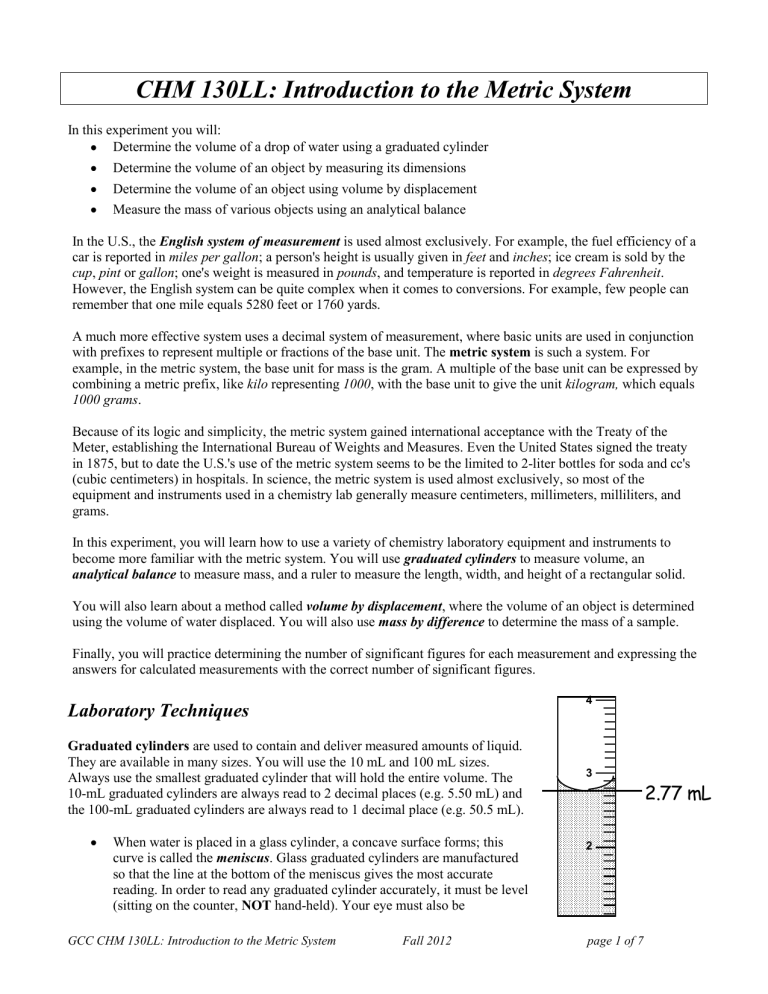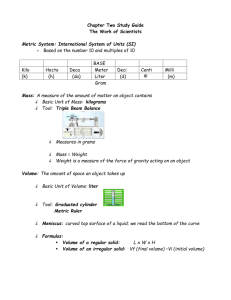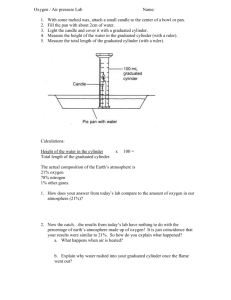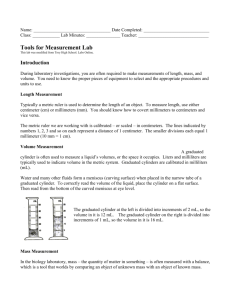CHM 130LL

CHM 130LL: Introduction to the Metric System
In this experiment you will:
Determine the volume of a drop of water using a graduated cylinder
Determine the volume of an object by measuring its dimensions
Determine the volume of an object using volume by displacement
Measure the mass of various objects using an analytical balance
In the U.S., the English system of measurement is used almost exclusively. For example, the fuel efficiency of a car is reported in miles per gallon ; a person's height is usually given in feet and inches ; ice cream is sold by the cup , pint or gallon ; one's weight is measured in pounds , and temperature is reported in degrees Fahrenheit .
However, the English system can be quite complex when it comes to conversions. For example, few people can remember that one mile equals 5280 feet or 1760 yards.
A much more effective system uses a decimal system of measurement, where basic units are used in conjunction with prefixes to represent multiple or fractions of the base unit. The metric system is such a system. For example, in the metric system, the base unit for mass is the gram. A multiple of the base unit can be expressed by combining a metric prefix, like kilo representing 1000 , with the base unit to give the unit kilogram, which equals
1000 grams .
Because of its logic and simplicity, the metric system gained international acceptance with the Treaty of the
Meter, establishing the International Bureau of Weights and Measures. Even the United States signed the treaty in 1875, but to date the U.S.'s use of the metric system seems to be the limited to 2-liter bottles for soda and cc's
(cubic centimeters) in hospitals. In science, the metric system is used almost exclusively, so most of the equipment and instruments used in a chemistry lab generally measure centimeters, millimeters, milliliters, and grams.
In this experiment, you will learn how to use a variety of chemistry laboratory equipment and instruments to become more familiar with the metric system. You will use graduated cylinders to measure volume, an analytical balance to measure mass, and a ruler to measure the length, width, and height of a rectangular solid.
You will also learn about a method called volume by displacement , where the volume of an object is determined using the volume of water displaced. You will also use mass by difference to determine the mass of a sample.
Finally, you will practice determining the number of significant figures for each measurement and expressing the answers for calculated measurements with the correct number of significant figures.
4
Laboratory Techniques
Graduated cylinders are used to contain and deliver measured amounts of liquid.
They are available in many sizes. You will use the 10 mL and 100 mL sizes.
Always use the smallest graduated cylinder that will hold the entire volume. The
10-mL graduated cylinders are always read to 2 decimal places (e.g. 5.50 mL) and the 100-mL graduated cylinders are always read to 1 decimal place (e.g. 50.5 mL).
When water is placed in a glass cylinder, a concave surface forms; this curve is called the meniscus . Glass graduated cylinders are manufactured so that the line at the bottom of the meniscus gives the most accurate reading. In order to read any graduated cylinder accurately, it must be level
(sitting on the counter, NOT hand-held). Your eye must also be
3
2
2.77 mL
GCC CHM 130LL: Introduction to the Metric System Fall 2012 page 1 of 7
perpendicular to the water level. Note that the graduations on all cylinders rise from the bottom up. That is, they indicate the volume contained in the cylinder.
The 10-mL graduated cylinder above is read to two decimal places (to the nearest 0.01 mL). Thus, the volume of liquid is read to be 2.77 mL.
Note that 100-mL graduated cylinders have markings for each mL, so they are read to one decimal place (to the nearest 0.1 mL).
Rulers: The basic metric unit of length is the meter, but the length of most objects in a chemistry lab are measured in centimeters ( cm ). A centimeter equals 0.01m or 1
100
100 cents (since one cent is equal to 1
100 of a dollar).
of a meter , so 1m 100cm just like 1 dollar
Several instruments are used for metric length measurements, such as a centimeter ruler in the example below.
The numbers shown on a centimeter ruler are centimeters (cm), and the 10 smaller markings between each number represent millimeters (mm). (Note that 10mm 1cm .) When measuring, always place an object at the
“0” mark.
Consider the stick and ruler below:
0 1 2
When taking a measurement, all the digits are known with certainty, except the last digit, which is estimated. If the object appears to be exactly on a marking, then the estimated digit is 0. If the object appears to be exactly halfway between two markings, the estimated digit is 5. The stick above appears to be a little past the halfway point between 1.2 and 1.3, so its length is recorded as 1.27 cm.
Balances: In most chemistry labs, balances are used to determine the mass of a sample. The metric unit of mass is the gram. You will use electronic balances. These balances are very expensive, very sensitive and must be used very carefully to avoid damage. The general procedure follows. The most important rule is NEVER place any chemical directly on the balance pan. Use a beaker, a watch glass, a plastic weighing cup, or weighing paper.
The balances are to remain “ON” at all times.
All doors are to remain closed at all times, except when loading or unloading the balance.
Do not lean on the balance table. (The balance is sensitve enough to measure vibrations on the countertop due to students leaning on it.)
Material to be weighed should be placed in a container on the balance pan. The container may be either pre-weighed or “ tared ” (as explained later).
Before weighing, be sure the doors are closed and the digital scale reads 0.0000 g. (4 zeros past decimal).
If zeroes are not displayed on the scale, gently click the front lever until the balance displays zeros. If
0.00000 g (5 zeros past decimal) is displayed or if the number displayed continues to drift, consult your instructor.
To weigh an item, open the door, and carefully place the item on the center of the pan. Close the door and wait for the digital readout to stabilize (the green light to the left of the readout will go off). Read and record all the numbers in the digital readout. ( Never round any numbers reported on any electronic instrument.
) Remove the item and close the doors before leaving.
If you are using a container to hold chemicals, you may tare the container. To do that, place the container carefully in the center of the pan. Close the doors. Briefly click on the left of the front lever (as in zeroing the balance). Zeros should appear. The container is now “tared out,” and the balance is set to read the
GCC CHM 130LL: Introduction to the Metric System Fall 2012 page 2 of 7
weight of any material added to the container. Remove the container from the balance, add material to it, and carefully place the container back on the center of the pan. (Do NOT re-zero the balance during this process.) Close the door and read the digital scale when stabilized as before. After you have removed the container, shut the doors and gently push the front lever to remove the tare and return the scale to zero.
Significant Figures (Sig figs)
Rules
1.
Digits 1 through 9 are always significant. (347 has 3 sig figs)
2.
Zeroes in front are never significant. (0.00024 has 2 sig figs)
3.
Zeroes in between significant digits are always significant. (7030 has 3 sig figs)
4.
Zeroes after a number are significant if they are ALSO after a decimal place. (0.3500 has 4 sig figs)
Addition and subtraction – the answer has the same number of decimal places as the least decimal places in the calculation. (24.6 – 9.2456 = 15.4 because the answer must have one decimal place)
Multiplication and division – the answer has the same number of significant digits as the least significant number in the calculation. (42 x 4378 = 180,000 because the answer must have two sig figs)
Procedure
A. INVESTIGATING MASS
1.
Review the instructions in the Laboratory Techniques section for using the electronic balances.
2.
In the plastic shoebox-size container at your lab station, you will find various objects. Use the electronic balance to measure the mass of each of the following objects: a small paper clip, a large paper clip, the cap of a ballpoint pen, and one sheet of paper (folded 4 times to fit on the balance pan). Be sure to place each object near the center of the balance pan to weigh it. Record the mass of each object to 4 decimal places , as displayed by the balance. NEVER round the mass reported on an electronic balance!
3.
Indicate the number of significant figures for each mass measurement, then answer the questions at the end of Part A on the Lab Report form.
B. INVESTIGATING LENGTH AND VOLUME
1. Review the instructions in the Laboratory Techniques section for using centimeter rulers. Be sure to use the side with markings in centimeters and millimeters ( not inches ).
2.
Measure the length, width, and height of the rectangular metal solid. Record each dimension in centimeters ( to 2 decimal places ). The little lines are millimeters by the way.
3.
Answer the questions on length and significant figures. Calculate the volume of the rectangular object using the formula below. Be sure to record the volume with the correct units. volume = length width height
4.
Review the instructions in the Laboratory Techniques section for using graduated cylinders .
5.
Obtain about 50 mL of tap water in your 150-mL beaker using the markings on the beaker. Pour the water from the beaker to your 100-mL graduated cylinder to about the 40-mL mark. Record the exact volume of water in the graduated cylinder (to 1 decimal place).
6.
Tilt the graduated cylinder until it is at an angle, and carefully lower the rectangular solid so as not to splash any water out of the graduated cylinder. Slowly return the graduated cylinder to an
GCC CHM 130LL: Introduction to the Metric System Fall 2012 page 3 of 7
upright position to avoid the metal piece hitting and breaking the glass bottom of the graduated cylinder. Read and record the exact new volume of water (to 1 decimal place).
7.
Subtract the original volume of water from the final volume of water, and record the difference
(to 1 decimal place) with the appropriate units.
8.
Compare the two volumes determined for the rectangular object, and answer the questions at the end of Part B.
C. INVESTIGATING DI WATER
1. Review the instructions in the Laboratory Techniques section for using Balances , particularly the section on how to Tare the Balance.
2.
Obtain about 20 mL of deionized (DI) water in your 50-mL beaker using the markings on the beaker.
3.
Carefully place a dry plastic weighing cup in the center of the pan in an analytical balance. Close all the doors, and tare (or zero) the balance. The display should now read 0.0000 g.
4.
Open the door, and carefully remove the plastic weighing cup. Use a disposable pipet to add one drop of water into the plastic weighing cup. Return the cup to the balance, close the door, and record the mass of one drop of water.
5. Review the instructions in the Laboratory Techniques section for using graduated cylinders .
6. Use a disposable pipet to add DI water to your 10-mL graduated cylinder exactly to the 4.00 mL mark.
7. Make sure the outside of the graduated cylinder is completely dry, make sure the empty balance says 0.0000, then measure and record the mass of the graduated cylinder with 4.00 mL of DI water.
8. Next, you will determine the number of drops of water in one milliliter by carefully counting the number of drops required to raise the water level in the graduated cylinder to the 5.00 mL mark.
Record the number of drops of water used to get to the 5.00 mL mark (i.e., the number of drops equal to 1.00 mL).
9. Measure and record the mass of the graduated cylinder with 5.00 mL of DI water.
10. Subtract the initial mass (graduated cylinder + 4.00 mL DI water) from the new mass (graduated cylinder + 5.00 mL DI water) to get the mass of 1.00 mL of DI water. Record the difference (to 4 decimal places) with the appropriate units.
11. Calculate the number of drops of water in 1.00 mL by dividing the mass of 1.00 mL of DI water by the mass of one drop of water. Compare your answer with your experimentally determined number of drops from step 8 above.
Put everything back where you found it. Wipe up any spills.
Wash your hands and your bench.
GCC CHM 130LL: Introduction to the Metric System Fall 2012 page 4 of 7
CHM 130LL:
Name: ________________________
Introduction to the Metric System
Partner: _______________________
Section Number: ________________
DATA
A.
INVESTIGATING MASS
OBJECT MASS # of Significant Figures small paper clip large paper clip cap of a ballpoint pen one sheet of blank paper
Which object has a mass that is closest to 1.0000 g? __________________________
B.
INVESTIGATING LENGTH AND VOLUME
Volume by Calculation Volume by Displacement
Dimension Measurement
# of Sig
Figs Volume Measured Water Level length initial (w/o metal) width final (with metal) height
Calculate the volume using the formula: volume = length width height
Volume of metal by Calculation: __________________ with correct # of sig figs and units
# of
Decimal
Places
Calculate the volume using the formula: volume of metal = final volume – initial volume
Volume of metal
by Displacement: __________________
with correct # of decimal places and units
Questions:
1. Which of your two volumes has the greatest number of significant figures, and thus, is the more accurate method for determining volume? (Circle one)
Volume by Calculation Volume by Displacement
Note: Your two volumes should be very close in number even though their units are different. This is because 1 mL 1 cm
3
(or cc). This is an important relationship as milliliters and cubic centimeters are commonly used in chemistry.
GCC CHM 130LL: Introduction to the Metric System Fall 2012 page 5 of 7
C.
INVESTIGATING WATER one drop of DI water
MASS # of Sig Figs
MASS
# of Decimal
Places
Graduated cylinder + 4.00 mL DI water
Graduated cylinder + 5.00 mL DI water
1.00 mL of DI water
Number of drops of water in 1.00 mL by counting drops: _________________
Calculations and Questions:
1. Calculate the number of drops of water in 1.00 mL using the formula below:
# of drops in 1.00 mL DI water =
Mass of 1.00 mL of DI water g g
= _________________ drops/mL
2.
Indicate the two values you determined for number of drops in 1.00 mL DI water.
# of drops by counting=_____________ # of drops using masses= ______________
How similar are these values? Provide possible experimental sources for error that could account for the difference in the numbers you determined.
3.
Put your mass for 1.00 mL DI water over 1.00 mL, then divide the numbers, and record your answer with the correct number of significant figures:
Mass of 1.00 mL of DI water
1.00 mL
= _______________ g/mL
1.00 mL
Note: Your answer should be very close to 1.00 g/mL since the quantity you calculated is the density of water, which is about 1.00 g/mL at room temperature.
GCC CHM 130LL: Introduction to the Metric System Fall 2012 page 6 of 7
Post Lab Questions
1.
How many significant figures are in each of the following numbers? a.
24,005 mm ________________ b.
0.03050 kg ________________ c.
34,500 mL ________________ d.
0.004 km ________________ e.
0.00400 mg ________________ f.
2000 lbs ________________ g.
94,525 cm ________________ h.
8040 oz ________________
2.
Perform the following calculations and write the answer with the correct number of significant digits and unit in the provided blank. a.
3.593 cm + 1.4 cm + 24.63 cm = ___________________ b.
19.42 mg – 6.3 mg = ________________ c.
71 mm x 255 mm = ______________ d.
9.24 g / 0.1535 mL = ______________ e.
0.008753 km x 0.048 km = __________________ f.
1.005 kg / 0.0356 L = _________________ g.
9.25 g + 17 g = ________________ h.
0.45698 L – 0.084 L = __________________
GCC CHM 130LL: Introduction to the Metric System Fall 2012 page 7 of 7









